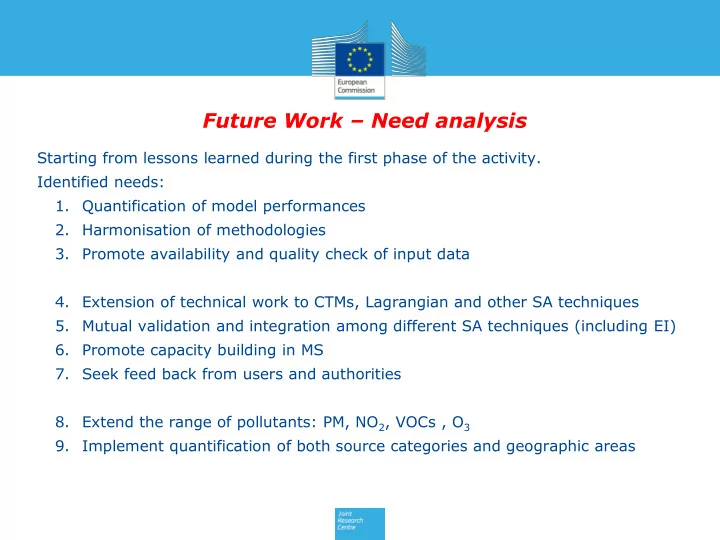

Future Work – Need analysis Starting from lessons learned during the first phase of the activity. Identified needs: 1. Quantification of model performances 2. Harmonisation of methodologies 3. Promote availability and quality check of input data 4. Extension of technical work to CTMs, Lagrangian and other SA techniques 5. Mutual validation and integration among different SA techniques (including EI) 6. Promote capacity building in MS 7. Seek feed back from users and authorities 8. Extend the range of pollutants: PM, NO 2 , VOCs , O 3 9. Implement quantification of both source categories and geographic areas
FAIRMODE WG3 – Proposed activities 2014-2016 Main activities 1. Inter-comparison for receptor-oriented and source- oriented models in collaboration with EURODELTA Development of indicators and evaluation methodology 2. Development of website with repository for European source profiles 3. Capacity building initiatives Other activities 1. Test and update current Common Protocol for Source Apportionment – feed back from users. 2. Explore spatial representativeness of source contribution estimations 3. Validation with EIs
FAIRMODE WG3 – Contributions 1. Summarized the activity in the first 3 years and list the deliverables 2. Plenary talk 3. Coomments on the Common Protocol and advice on future direction (J. Watson) 4. Exhaustive discussion on measuring techniques for generating source profiles (J. Chow) 5. Role of SA in the TSAP and e-reporting 6. Presentation on specific sources : non exhaust (F. Amato), biomass burning (R. Vecchi), Ship emissions (P. Prati) 7. Presentation on methdologies and sites Robotic CMB (G. Argyropoulos), Organic tracers (J.L. Jaffrezo), ACSM intercomparison (R. Froelich) 8. SA with CTMs and RMs (C. Hendriks, G. Pirovano, B. Bessagnet)
JOINT SA INTERCOMPARISON PROPOSED SET UP RMs • One reference site with a dataset suitable for RMs provided by the organisers • Secondary sites in the areas selected by participants where dataseta are available CTMs • Large European domain (EURODELTA) at medium resolution (ca. 28x28km) • Many smaller National/Regional domains around the reference and secondary sites at higher resolution (ca. 7x7 km)
Intercomparison exercise Phase I – Comparison at a reference site (France) Phase II – Comparison at secondary sites Timelines for Phase I 1) Input data 1) Observed data at the receptor (for RMs) 2) Emission inventory (anthropogenic sources) 3) Emission speciation profiles 4) Meteorology for the European and reference site 5) Boundary conditions 6) Other observed data (Air quality and meteorology) 2) Output data 1) CTMs at European and local scale SCE at the reference site 2) RMs SCE at the reference site
Questions for WG2Mobile sources & PM Four questions to be addressed 1) Estimation of Primary PM total mass (Exhaust / Non-Exhaust) 2) Emission source speciation profiles (EC/OC, tracers ,…) 3) Estimation of gas phase precursors of secondary aerosol (VOC, SVOC,…) 4) Road dust resuspension (estimates? What’s the suitability of on - line models for CTMs?)
FAIRMODE WG3 – CCAs 1. Monitoring and Modelling Availability of advanced monitoring data either for input or for validation of source apportionment output. 2. Spatial representativeness Due to the kind of available data, a priori estimation of representativeness seems to be the most suitable methodology for understanding the representativeness of the sources deriving from measurements in one single point. Geostatical approach would required many contemporaneous measurements.
FAIRMODE WG3 – Highlights 1. The two approaches (RMs and CTMs) are complementary and not mutually excluding because the strengths of one are useful to understand the weakness in the other and viceversa 2. The Common Protocol received appreciation and participants agreed to promote the implementation in future studies and provide feed-back. 3. The repository of source profiles turned out to be of transversal interest (WG2 and WG3). 4. E- reporting: WG3 expressed concern about the current provisions in the IPR that are not fully consistent with the most up to date methodologies for source apportionment.
Thank you for your attention
Recommend
More recommend